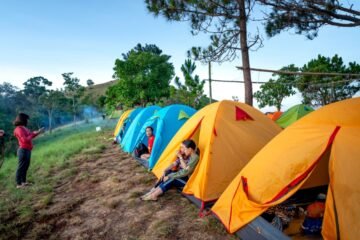Hiking on the Puffin Island of Mykines
[ad_1]
Throughout my adult life, I’ve made a conscious effort to go somewhere different every year. Whether it be a far-flung corner on the other side of the world or an off-the-grid beach a few hours’ drive from home, the destination is never as important as following through on the choice. Call it a lifelong commitment to curiosity.
The most recent manifestation of this multi-decade pact was a trip to the Nordic region. The first stop on the journey was a remote and rainswept island chain by the name of Faroe……….

A few hours after arriving in the Faroes, I caught an afternoon ferry to Mykines, the westernmost island of the archipelago. Among those on hand to greet me was a circus of the outpost’s most famous residents. With their black and white plumage, rotund little bodies, waddling gait, and seasonally colorful beaks and feet, puffins look like a cross between a toucan and a penguin. However, don’t be fooled by their comical appearance. Puffins are incredible flyers and swimmers – when sufficiently motivated (i.e., when they are hungry or in danger), they can move up to 88 km (54.7 mi) an hour in the air and dive down to 60 m (197 ft) below the ocean’s surface.

Mykines has around 40 houses, only six of which are occupied all year round. It has a church, shop/restaurant, seasonal guesthouse, a spotless public bathroom, and 11 permanent residents. During my time there, I set up camp by a stream overlooking the island’s namesake (and only) village.

MLD Duomid, meandering stream, and turf-roofed cottages.

Mykines village

The village church

Yours truly wandering around the surrounding hills during my first afternoon on the island.
“Alright, enough with the preambles, what about the hiking?”
There are two main rambling options on Mykines (GPS Data). The out-and-back trail to the lighthouse (aka Mykineshólmur Trail) and the longer loop hike to the island’s high point of Knúkur (560 m/1,837 ft). I wish I could tell you that both excursions went off without a hitch. Alas, that would be untrue on multiple fronts.
First up, the Mykineshólmur Trail. Measuring 5.3 km and taking an average of two to three hours to complete, this is the island’s signature trail and the one that’s tackled by most visitors. Unfortunately, for the past couple of years, the westernmost section of the path (which includes the lighthouse) has been inaccessible due to a landslide.



I was aware of the closure before I arrived, so I wasn’t too bummed. In case you’re wondering what the Mykines lighthouse looks like, here’s a pic from Wikimedia Commons.
 “Mykines and Mykinesholmur Faroe Islands” / 16 June, 2008 / By Erik Christensen (CC BY-SA 4.0)
“Mykines and Mykinesholmur Faroe Islands” / 16 June, 2008 / By Erik Christensen (CC BY-SA 4.0)
As an alternative, I parked myself on the cliff’s edge and spent a couple of hours observing puffins and listening to the North Atlantic Ocean (Fun fact: During the spring mating season, puffins’ beaks and feet transform from dull grey to striking orange, making them more attractive to potential suitors (and snap-happy tourists). Once they find a mate, puffins are usually monogamous, going back to the same partner every breeding season for up to twenty years (the average life span of puffins)).
When it was eventually time to move on, I headed eastwards. During my walk, I passed by geese and sheep and soaked in some incredible sea cliff vistas.




By the time I returned to the village, it was getting late and had started to rain. Over the next 18 hours, it absolutely belted down and was windier than an AYCE bean buffet. Nonetheless, upon waking the following morning, I packed up my stuff and headed east to Knúkur, the rooftop of Mykines.
What were my impressions of the Knúkur trail? The “Shark Sandwich” review from “This is Spinal Tap” comes to mind.



On the rooftop of Mykines
Jokes and movie analogies aside, I still enjoyed myself despite seeing bugger all.
Yes, the weather was less than stellar, but I was warm and dry(ish) thanks to my fleece/rain jacket combo. And I was hiking in a place I had dreamed of visiting for more than three decades. As I’ve written on this website before, if you spend enough time in the boonies over enough years, meteorologically speaking, things have a way of evening themselves out. There’s no point moaning and what-iffing. Just make sure you have the right gear and the ability to have a chuckle in the face of adversity.
By the time conditions cleared late in the afternoon, I had a ferry to catch back to Sørvágur. Over my next week in the Faroes, things improved considerably on the weather front. However, reflecting on those initial days, I wouldn’t change a thing. I had the privilege of observing lots of puffins with no one else around, and being buffeted by wind and rain seemed climatically appropriate for a starkly beautiful place with an “edge of the world” feel. All in all, a good start to the journey.
For detailed information on Mykines, see the excellent Visit Vagar website.

Leaving Mykines, from where it’s a 45-minute boat ride back to Sørvágur.
[ad_2]
Source link



0 comentarios